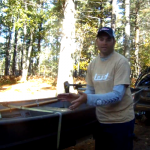Timing is everything in life, and nowhere is this truer than in walleye fishing. Hover over a hot reef during a suicide bite and hungry ’eyes make you a hero. Try the same tactics after a crushing cold front, however, and you’ll plummet from the penthouse to the outhouse. This explains why veteran guides—who get paid to put clients on fish no matter the conditions—use timing to their favor whenever possible. Knowing where active fish gather, when, makes a huge difference in their catches. For longtime guide Jon Thelen, whose territory includes Minnesota’s storied Mille Lacs Lake, the mid- to late fall time frame offers some of the season’s finest and most consistent patterns.
“People put their boats away way too early,” he says, lamenting the lines of shrink-wrapped hulls decorating marine dealers’ lots come mid-October. “They’re missing out on some of the best walleye fishing of the year.”
What makes this period so special, he says, is walleyes are so dependent on Mother Nature—particularly water temperature and wind direction—that profiling their behavior becomes infinitely easier than during other times of year.
First, falling water temperatures trigger baitfish to move into shallow water. Some, such as tullibees, do so for spawning, while others seek food and warmer water. Walleyes follow, and this makes them just as vulnerable as they were early in the season.
“The only difference is, because we’re not waiting for the water to warm up like we were in spring, the fish are more active—and feeding more aggressively,” Thelen says.
Secondly, wind often dictates fish location. It concentrates baitfish and walleyes on small, predictable, easy-to-fish areas such as points. Thelen favors windswept structure because it cuts light penetration while bringing the water temperature up a few degrees. By monitoring wind forecasts, it’s possible to plan a milk run of promising points several days in advance of the trip. When weather changes trump predictions, a backup plan can be a trip-saver, so it’s wise to learn a lake’s entire portfolio of structural sweet spots so you can make on-the-water adjustments as needed.
Not all points are created equal. Thelen likes hard-bottom outcroppings offering easy access to deep water on both sides. Walleyes prefer having deepwater shelter close by their feeding areas. Wind-beaten banks may also hold walleyes, but Thelen says the fish are more concentrated on points.
“Large, expansive shorelines often feature a mix of rocks and dying vegetation, which leads to scattered fish. It’s much easier to zero in on points where the fish are concentrated,” he said.
 When plying a prime point, Thelen considers four specific zones—the top, front side, downwind side and tip.
When plying a prime point, Thelen considers four specific zones—the top, front side, downwind side and tip.
“Plenty of people only fish the front—or upwind side. But just as with wing dams in rivers, there are times when walleyes prefer to hold on the back side and ambush baitfish pushed over the top,” he says.
Depending on factors ranging from water depth and clarity to the shape of the structure and strength of the wind, the tip may also hold the most active fish. To quickly hit the hot zone, Thelen invariably attacks from upwind and methodically covers the front face, tip, top and downwind side of the point.
“Always start on the windy side,” he says.
While approaching the structure, he eyes his electronics for signs of life below, though he cautions against judging a point’s potential solely on sonar.
“I watch for baitfish and larger arches when I first roll in,” he says. “But on the 10- to 12-foot edges I typically target, the fish may blend into the bottom or flare away from the boat, making them tough to mark.”
A far more reliable measure is actually catching fish, of course, and Thelen’s go-to presentation toward that end is a light jig tipped with a minnow.
“We’re not talking vertical jigging, here,” he says. “The line should trail at about a 45-degree angle to the water.”
On the point’s sides and tip, he drifts with the wind, using a Lindy Wave Tamer or Drift Control drift sock to slow boat speed, and his electric trolling motor to work specific depths. Casts cover the top of the point, which is typically too shallow to safely or effectively drift-fish.
“Most points I fish top out at about 4 feet,” he says. “With 2-foot waves, you’re dropping within 2 feet of the bottom when you’re in the wave trough—and that’s way too close for comfort.”

The presentation is the same for both casting and drifting. Leadheads, just heavy enough to maintain bottom contact, range from 1/8- to ¼-ounce in weight. He prefers the Watsit or Fuzz-E Grub for the extra bulk and tail action. Colors trend toward natural tones except in low-vis conditions, which call for brighter patterns. Thelen sweetens the pot with a 3-inch rainbow chub or shiner minnow, skull-hooked for safekeeping during animated jig strokes. Because he’s adding all of the action, a lively minnow isn’t necessary. After letting the jig touch down, Thelen snaps it upward 18 inches with a sharp rip of the rodtip, then lets it pendulum to bottom on a semi-tight line.
“Don’t lower your tip too fast during the drop,” he warns. “Keep it up, so you can feel or see strikes. Most fish hit on the fall, and with slack in the line you’ll miss them.”
When a walleye hits, Thelen responds with an immediate hookset.
“You don’t have to cross their eyes like a bass in milfoil,” he says. “A solid, steady set is fine. Just pull back the rodtip while reeling. If you drop the tip, it gives the fish a chance to shake the jig free.”
Thelen’s point system produces fine fishing once the water temperature begins dropping, and holds up all the way to freeze-up. Whenever autumn winds whip a shoreline point, it’s worth a whirl for anglers hoping to be in the right place at the right time.






